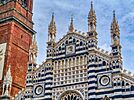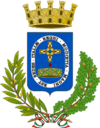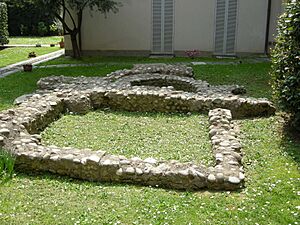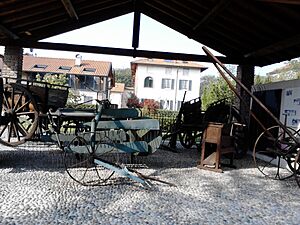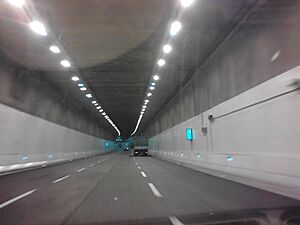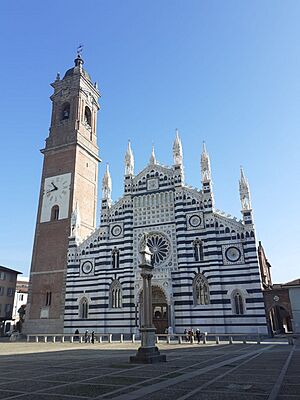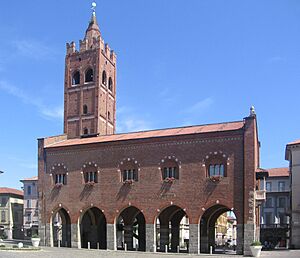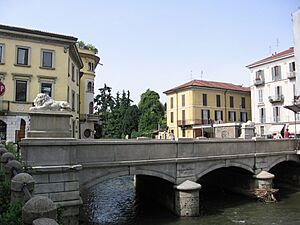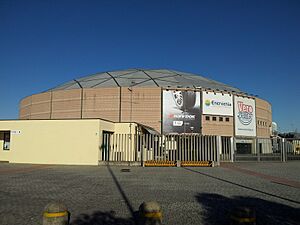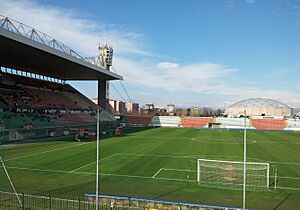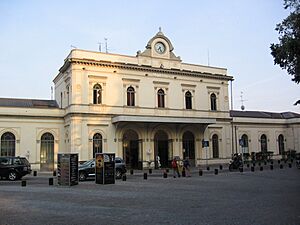Monza facts for kids
Quick facts for kids
Monza
Monscia (Lombard)
|
|||
|---|---|---|---|
| Comune di Monza | |||
|
From top, left to right: Royal Villa of Monza; Monza Cathedral; Monumento ai Caduti; Expiatory Chapel of Monza; Arengario; Monza Circuit; and Monza Park
|
|||
|
|||
| Country | Italy | ||
| Region | Lombardy | ||
| Province | Monza and Brianza (MB) | ||
| Area | |||
| • Total | 33.03 km2 (12.75 sq mi) | ||
| Elevation | 162 m (531 ft) | ||
| Population
(31 August 2020)
|
|||
| • Total | 124,398 | ||
| • Density | 3,766.2/km2 (9,754.4/sq mi) | ||
| Demonym(s) | Monzesi | ||
| Time zone | UTC+1 (CET) | ||
| • Summer (DST) | UTC+2 (CEST) | ||
| Postal code |
20900
|
||
| Dialing code | 039 | ||
| Patron saint | Saint John the Baptist, Saint Gerardo dei Tintori | ||
| Saint day | 24 June, 6 June | ||
Monza is a city in the Lombardy region of Italy. It's located about 15 kilometers (9 miles) north of Milan, right on the River Lambro. Monza is the main city of the province of Monza and Brianza. It's most famous for its Grand Prix motor racing track, the Autodromo Nazionale di Monza, which hosts the exciting Formula One Italian Grand Prix. Monza is the third-largest city in Lombardy and an important center for business and industry in the Brianza area. It's also home to a part of the University of Milano-Bicocca. Monza Park is one of the biggest city parks in Europe.
Contents
Monza's Location and Landscape
Monza is in the flat plains of Lombardy, between the Brianza area and Milan. It sits about 162 meters (531 feet) above sea level. While it's about 15 kilometers (9 miles) from central Milan, the city borders are actually less than 5 kilometers (3 miles) apart. Monza is also about 40 kilometers (25 miles) from Lecco and Como.
The Lambro river flows through Monza from north to south. A special branch of the river, called the Lambretto, was created in the 14th century for defense. It later rejoins the main Lambro river. Another artificial waterway, the Canale Villoresi, was built in the late 1800s.
Monza has a climate similar to the Po valley. Winters are cool and short, and summers are warm. Temperatures average around 2°C (36°F) in January (the coldest month) and about 23°C (73°F) in July (the warmest). It rains a lot, especially in autumn, but the city usually doesn't have droughts.
A Look Back: Monza's History
Early Times
Ancient burial urns found in Monza show that people lived here as far back as the Bronze Age. They likely lived in pile dwellings (houses built on stilts) over rivers and marshes.
During the Roman Empire, Monza was called Modicia. Around 200 BCE, the Romans took over the Insubres, a Gaul tribe living near Milan. This tribe probably founded a village on the Lambro river. You can still see parts of an old Roman bridge, Ponte d'Arena, near today's Ponte dei Leoni (Lions Bridge).
The Middle Ages
Theodelinda, a queen of the Lombards, chose Monza as her summer home around 595 CE. She built a special chapel dedicated to St. John the Baptist. Legend says that a dove in her dream told her to build "here" (modo in Latin), and she replied "yes" (etiam). This is how the medieval name "Modoetia" might have come about. She also built a palace here.
Later, Berengar I of Italy made Monza his main base. He built a fort to protect against Hungarian attacks. Under his rule, Monza became somewhat independent. It had its own ways of measuring things and could even sign official documents. Berengar gave many gifts to the Monza Cathedral, including a famous cross.
In 980, Emperor Otto II visited Monza. In 1000, Emperor Otto III became Monza's protector.
In 1018, Aribert, who was Lord of Monza, became the bishop of Milan. This meant Monza lost some of its independence from Milan.
By the 12th century, Monza had about 7,000 people. Most people worked in farming, but crafts were also becoming important. In 1128, Conrad III was crowned King of Italy in Monza.
In 1136, Emperor Lothair III made sure Monza's church leaders were independent from Milan. Monza gained more freedom, even controlling its own lands and goods.
Frederick I Barbarossa visited Monza twice. He declared Monza his own property and gave it special rights, usually only given to royal cities. This independence lasted until 1185.
In 1185, Henry VI, Barbarossa's son, was crowned king in Monza.
Monza was a fortified city by the 12th century. Besides farming, it started making clothes, and wool processing grew. Monza's history became closely linked to Milan's. In 1255, the city was attacked, and in 1259, it was set on fire.
From the 1300s to the 1700s
In 1312, Monza joined the Ghibelline group. In 1322, Enrico Aliprandi was named Lord of Monza. That same year, the walls of Monza were torn down to stop the city from defending itself against Milan.
In 1325, Galeazzo I Visconti took over Monza and started building new defenses. This included dividing the Lambro River to create the "Lambretto" branch and building a new castle. The castle had a 42-meter (138-foot) tall tower used as a jail.
In 1354, Pope Innocent VI said that the Iron Crown could only be used for coronations in the Monza Cathedral. In 1407, Estorre Visconti became Lord of Monza and started making Monza's own coins.
In 1527, the Spanish governor of Milan, Antonio de Leyva, attacked Monza. A mine exploded, partly destroying the castle.
The plague hit Monza in 1576 and 1630, causing a big drop in population and economic problems. Monza remained under Spanish rule until the early 1700s.
The 1700s and 1800s
After a war in 1713, Monza became part of the Austrian Empire. This was a time of new growth for the city, with farming and crafts improving.
Empress Maria Theresa built the beautiful Royal Villa of Monza for her son Ferdinand, who was the Governor of Milan (1777–1780). She chose Monza because of its beauty, its important location, and its connection to Vienna and Milan.
When Napoleon Bonaparte took over Italy in 1796, Monza became part of the French Republic. The Royal Villa was almost destroyed because it was seen as a symbol of the old rulers, but people's protests saved it.
In 1805, Napoleon was crowned King of Italy in Milan, using the Iron Crown. He famously said, "God gave it to me, woe to anyone who touches it." Monza was given the title of Imperial City. The castle was torn down in 1807.
After Napoleon's empire fell in 1815, Austria took control again. Monza got back its treasures that Napoleon had taken, but the Crown of Agilulf had been melted down.
In 1838, the next emperor, Ferdinand I of Austria, was crowned with the Iron Crown in Milan. He brought many good things to Monza, like new roads and the first railway connecting Milan and Monza in 1841.
Monza joined the "Five Days of Milan" uprising in 1848, pushing out the Austrian soldiers. But the Austrians returned in 1849.
In 1859, Lombardy became part of the Kingdom of Sardinia. The Iron Crown was taken to Vienna by the Austrians but was returned to Monza in 1866.
By 1895, Monza had about 37,500 people. Its economy relied on growing crops like wheat and corn, and raising silkworms.
In 1900, King Umberto I was assassinated in Monza. To remember him, the Expiatory Chapel was built.
The 1900s and 2000s
At the start of the 20th century, Monza had 41,200 people and was one of Italy's most industrial cities. It was known for cotton, machinery, and hat factories.
Between the two world wars, Monza's industries grew a lot. The famous Autodromo (race track) was built in 1922, and a golf course in 1925, both in the park.
During World War II, Monza was bombed, and people were hurt. After 1943, the Germans occupied the area.
In the second half of the century, Monza's population grew a lot, leading to more buildings and traffic problems.
In 2004, Monza became the capital of the new Province of Monza and Brianza. From 2009 to 2013, a tunnel was built to help with traffic on one of Europe's busiest roads, Viale Lombardia.
Cool Places to See in Monza
Monza has many interesting historical buildings and sights:
- Monza Cathedral (Duomo): This church is built in a mix of Romanesque and Gothic styles. Its black-and-white marble front was built in the mid-1300s. The bell tower was added in 1606.
- Inside the Cathedral is the Chapel of Theodelinda. This chapel holds the famous Iron Crown of Lombardy. Legend says this crown contains one of the nails used when Jesus was crucified. The treasury also has Queen Theodelinda's crown, fan, and a golden comb. You can also see a golden hen with seven chickens, which represent Lombardy and its seven provinces.
- Santa Maria in Strada: A medieval church with beautiful terra-cotta designs from 1393.
- Broletto or Arengario: This was the city's palace in the 14th century. It has a tall, square tower.
- San Pietro Martire: Another historic church.
- Santa Maria delle Grazie: A church built in the 15th century.
- Expiatory Chapel of Monza (Cappella Espiatoria): This memorial chapel was built in 1900 to remember King Umberto I of Italy after he was assassinated.
- Royal Villa: A grand villa built when the Austrians ruled Milan.
- Monza Park: This is one of the largest walled parks in Europe, covering about 685 hectares (1,690 acres). It's in the northern part of the city.
Other beautiful villas in Monza include Mirabello, Mirabellino, and Durini.
Culture and Learning
Food in Monza
Monza's food is typical of the Brianza area and is similar to Milanese cuisine. Some traditional dishes include cassoeula (a rich stew), buseca (tripe soup), and risotto with luganega (a type of sausage).
University
The University of Milan Bicocca has two departments in Monza: Medicine and Surgery, and Sociology.
Museums
The Duomo's (Cathedral) Museum has amazing treasures from the early Middle Ages, like the golden "Hen with Chicks" and the Iron Crown. It also has items from later periods.
Entertainment
Monza has several theaters, including Teatro Manzoni and Teatro Villoresi. There are also many cinemas like Sala San Carlo and Cinema Capitol.
Events
- The Italian Grand Prix Formula One race, usually held in early September.
- The Feast of Saint Gerardo dei Tintori, celebrated on June 6th.
Sports in Monza
The Monza Circuit
Monza is famous worldwide for the Autodromo Nazionale di Monza motor racing circuit. This track hosts the Italian Grand Prix every September. The circuit is located inside Monza Park.
The Italian Grand Prix has been held at Monza almost every year since Formula One began. Even though no Italian driver has won the race since 1966, local fans, called tifosi, strongly support the Ferrari team. Ferrari has won many times here, especially with Michael Schumacher winning five times.
Monza is an extremely fast circuit. It has been changed with three chicanes (sharp turns) to slow cars down, but it's still the fastest track on the Formula One calendar. Because it's so fast, it doesn't host MotoGP or Superbike World Championship races anymore. Sadly, the circuit has seen some tragic accidents involving drivers and even spectators over the years.
Other Sports
Monza's professional football team, AC Monza, plays at the Stadio Brianteo. They were promoted to the top Italian football league in 2022.
Monza also has a top men's volleyball team, Volley Milano, and a women's team, Pro Victoria Pallavolo Monza. Both play at the Monza Arena.
Getting Around Monza
Trains
Monza railway station is a very important train hub for the Brianza area. You can travel between Monza and Milan using local (suburban) trains or regional trains. These trains also connect Monza to cities like Lecco, Como, Bergamo, and even Lugano in Switzerland. Some international EuroCity trains also stop in Monza.
Work began in 2024 to extend Milan's subway Line M5 to Monza, adding 8 new stops within the city.
Roads
Monza can be reached by major highways like the A4 (Turin-Milan-Venice) and the Milan ring roads. The SS36 road connects Monza to Lecco and Sondrio. A 2-kilometer (1.2-mile) long tunnel was built to help reduce traffic in the city.
The very center of Monza is closed to cars to make it safer and more pleasant for walking.
Famous People from Monza
Many notable people have connections to Monza:
- Theodelinda (around 570–628), a Queen of Lombardy.
- Saint Gerardo dei Tintori (around 1134 or 1140–1207), a local saint.
- Giuseppe Arcimboldo (1527–1593), a famous painter.
- Paolo Mantegazza (1831–1910), a neurologist and anthropologist.
- Mosè Bianchi (1840–1904), a painter.
- Fiorenzo Magni (1920–2012), a well-known cyclist.
- Vittorio Brambilla (1937–2001), a Formula One racer.
- Gianni Bugno (1964), a cyclist.
- Matteo Pessina (1997), a footballer.
Monza's International Friends
Monza is twinned with:
 Indianapolis, Indiana, U.S.
Indianapolis, Indiana, U.S. Prague, Czech Republic
Prague, Czech Republic
Images for kids
See also
 In Spanish: Monza para niños
In Spanish: Monza para niños



